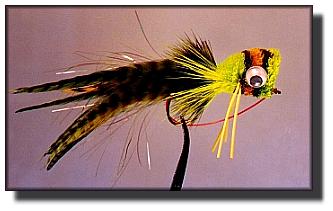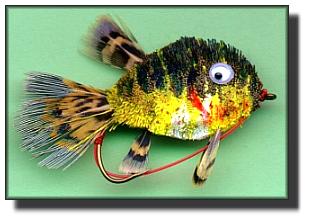Something about largemouth bass fishing during the warm days of spring
gets me excited. I don't know if it's trying to get over cabin fever or
just good fishing that gets me going, but I find myself working on bass
flies and dusting off the bass gear long before the ice of winter has
abandoned the lakes. In fact, I started tying bass flies so early this
year, I'm not sure I'll live long enough to use all of them. It was just
another way to enjoy the anticipation springtime bass fishing provides.
I knew it wouldn't be real good fishing before the water warmed up a bit,
but I was out there, flogging the water with all the energy I could muster
as soon as the ice cleared the lakes. Most springs, I'll get two or three
trips in before the water is warm enough to encourage feeding by any
self-respecting bass. I don't care, I just want to be there, to try, to
work on that feeling that winter is finally over and another short summer
is about to begin.
I guess it's about the time the frogs start to appear that fishing starts
to improve. Maybe the water is warm enough to turn on the feeding light
inside the largemouth's heads or maybe it's the sight of frogs that turns
the fish on. I don't really care what does it, as long as the fish decide
it's time to feed and they start looking at my flies with a hungry eye.
The first fish to bite are usually small. I'll catch several dozen bass
under 15 inches for every one over that length. To me, that's a bonus.
Not only are a few big bass hitting; there's plenty of action coming my way
in the form of hungry little bass. Heck, after a winter of snuggling the
wood stove and trying to stay warm, I'll take all the action I can find.
The shallow bays and flats of smaller lakes tend to be the first places to
become productive. As the sun warms these areas, bass move up from the
depths to work on their suntans. Oops, it's me working on the suntan; the
bass are looking for good places to spawn. If it's a good day for short
sleeves, it'll be a good day for bass fishing.
Spring is the time when bass are most mobile. If the water is warming,
they'll be moving to higher ground in anticipation of the spawning days
ahead. But, spring is a time of unpredictable weather, and cold spells
often send bass to the depths of the lake for days and weeks at a time.
It's a time when you might get totally skunked one day and catch several
dozen the next. Maybe that's why I love it so much; it's a time of wonder
and discovery.
Since the water is still rather cold during the first few days, the fish
are a little sluggish and won't spend too much valuable energy chasing down
flashy flies that scoot past them at a high rate of speed. A bead-head
wooly bugger in bright colors like yellow, white and chartreuse is a better
choice than a popper or diver until the water has had a few weeks to warm
up. Bunny leeches and ordinary wooly worms in bright colors are also good
flies this time of year.
As soon as I see a lot of frogs, I start searching the shallows with frog
colored Dahlberg Divers and crayfish patterns. Noisy surface flies like
cork poppers and hair-head bass poppers usually don't work as well before
the water warms enough for spawning to begin, but divers will usually do
the trick as soon as frogs start dotting the shorelines.

Like I said earlier, the first fish are usually small. These are the
males who have worked their way out of the depths to search out suitable
nesting sites for romantic encounters with the females who will be making
their entrance a little later. The males seem to be most aggressive and
usually provide the best action in terms of numbers and willingness to bite.
Depending on your location and the weather, it's usually somewhere between
mid March and mid May when the first females show up in the bedding areas.
If you probe the deeper water edges near the shallows with a sinking line,
you might pick up a few females a few weeks before they move into the
shallows to spawn.
I like numbers, but it's the big fish that excite me most. If I'm catching
a lot of little males, but can't seem to find a big female, it's time to
look on the edges for bigger fish waiting to move up into the shallows.
Large Clouser minnows, deceivers and bunny leaches are good patterns to
search out any big bass that are holding on the edges of deep water.
About two to five weeks after the males move into the shallows, the
females begin to arrive. That's when I switch to the big flies. Divers,
poppers and frog patterns will work then. In deeper lakes, bead and cone
head flies will also be productive. Even though they are preparing to
spawn, the bass are still mobile. They'll often hang near deep water,
moving in and out of the shallows with changes in weather and human activity.
This is the time when the biggest fish can be caught. They aren't
guarding their beds yet, but they are searching the neighborhood for
suitable lodging. Since I question the ethics of yanking females off their
beds, but I don't see anything wrong with catching and releasing them
before they set up housekeeping, I like the activity of this pre-spawn
period. However, if I see a female guarding her bed, I leave her alone.
She has a more important job to do than providing me with a few moments of
fun.
Post spawn periods can productive too. After spawning, big bass move to
structure near the shallows to stock up on groceries. They just lost up to
1/4 their body weight and they need to gain some of it back. Any fly that
looks like something edible is fair game during the weeks after spawning.
Some of the fish you catch are likely to be females looking to restore the
plump figure they once had. Some of them are going to be aggressive.

Patterns that imitate small panfish like perch, crappie and bluegills can
be killers when bass are in the post-spawn feeding frenzy. Sunken logs,
brush piles and stumps are good places to search for hungry bass looking
for an easy meal. I think I can handle that idea.
Yup, I like springtime bass fishing. I'd like it better if it started
earlier and lasted longer, but being absent from home that many days
wouldn't do well for my marriage. It's a little uncomfortable to return
home and find my pillow stuffed into the doghouse. Besides, summer isn't
far away, and that opens up a whole new set of possibilities.
~ Al Campbell
For more on flies for bass, check out
Intermediate Fly Tying!
|



